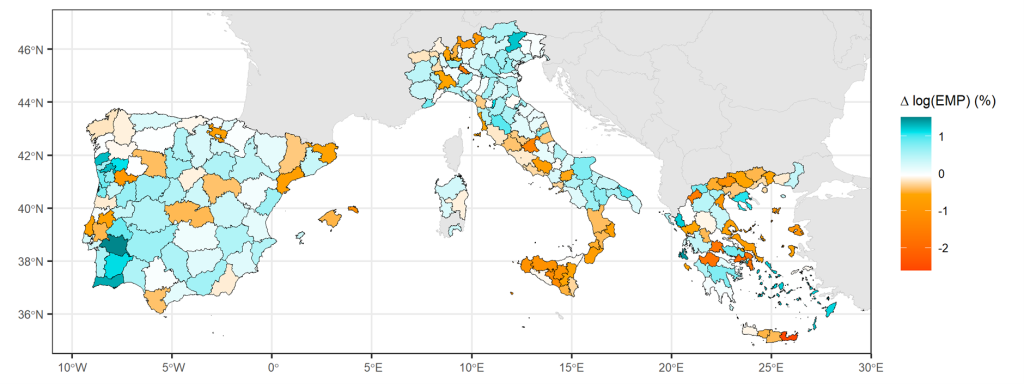
Written by Sarah Meier
Introduction
In recent years news coverage of orange-coloured skies, evacuations, and devastation caused by wildfires has become all too familiar. Even though one tends to only hear about the most calamitous and tragic of fires, every summer Southern European countries experience a large number of fires of varying degrees of seriousness (San-Miguel-Ayanz et al., 2022). These events can be highly disruptive and destructive, affecting many sectors of the economy, such as forestry and agriculture (Butry et al., 2001; Rego et al., 2013), industry and construction (Kramer et al., 2021; Wang et al., 2021), and recreation and tourism (Gellman et al., 2022; Otrachshenko & Nunes, 2022). One concern with the existing literature is that potential economic impacts may be disguised if aggregated data at the national level is used which means it is important to study the effect of natural disasters at the regional level (Horwich, 2000). In light of rising regional inequality in Southern Europe (Iammarino et al., 2019) and the potential for an increased risk of wildfires due to changes in the climate (Sullivan et al., 2022), being able to empirically quantify the regional effects of wildfires has important implications for policy making.
In recent research, forthcoming in the Journal of Environmental Economics and Management co-authored by Sarah Meier, Robert J.R. Elliott, and Eric Strobl at the University of Birmingham, UK, we show causal effects of wildfire numbers and burned area on the growth rates of the gross domestic product (GDP) and employment for Southern European regions. This open access article can be found using this link.
Data and Empirical Framework
We assemble a panel data set linking annual regional economic data on employment and gross domestic product provided by the Statistical Office of the European Union from 2010 to 2018 with satellite imagery on burned area for 233 Nomenclature of Territorial Units for Statistics level 3 (NUTS 3) regions in Portugal, Spain, Italy, and Greece. Figure 1 provides an overview of the study area and shows the annual average share of burned area for each NUTS 3 region over our period of our study. In addition to the share of burned area as a relative measure of wildfire impact we also measure the number of fires as an absolute measure.
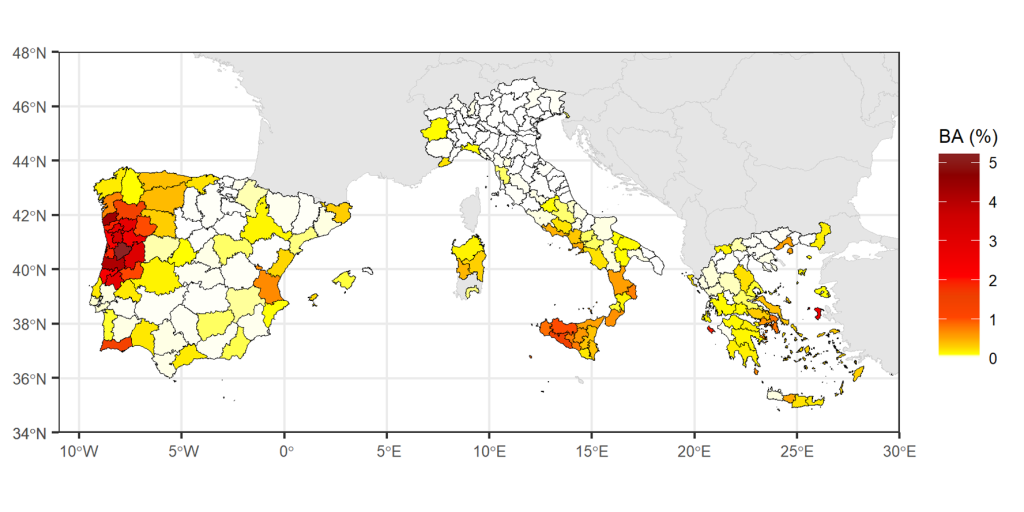
Figure 1: Average annual share of burned area (2011-2018).
In addition to the main variables of interest, we use remote sensed imagery on a number of climate variables (temperature, precipitation, relative humidity, and wind speed), a Fire Weather Index reanalysis product as an approximation of relative fire danger, and land cover maps to create the empirical framework to causally identify the effects of wildfires on the regional economy. Since there are many factors other than wildfires that affect the regional economies, we need a strategy to isolate the wildfire impact. To this end, we avail of the Fire Weather Index for predominantly forested areas in the summer months and use this as an instrumental variable.
Figure 2: Land cover types for the NUTS 3 region Rieti in Italy. The grid cells show the Fire Weather Index.
For illustrative purposes, Figure 2 shows the categorised land cover types as well as the Fire Weather Index raster using the example of the region Rieti in Italy. The forested area is mapped in green, orange captures agriculture, grey denotes urban areas, and blue shows water bodies and wetlands. For every intersection of the Fire Weather Index gridcell and region we tabulate the share of the four land cover types. If the intersection is predominantly forested, we match the region with that Fire Weather Index gridcell. Furthermore, we calculate the average daily values of all matching Fire Weather Index gridcells for the summer months for each region. To ensure we are excluding any potential impacts of meteorological factors on the regional economy through other channels such as through agricultural production (Damania et al., 2020) we implement two control vectors. The first one includes the Fire Weather Index for non-forested areas (i.e., urban, agricultural, wetlands) and the second one consists of annual and seasonal climate variables. For a deeper understanding of the instrumental variable method see the forthcoming article.
Results
Our causally identified results for Southern Europe show a consistent negative contemporary effect of wildfires on the annual regional GDP growth rate ranging from 0.11 to 0.18% for regions experiencing at least one wildfire. Using the average GDP/capita and average regional population we estimate production losses for each year derived by the multiplication of our estimates with the number of wildfire-affected regions. The results are shown in Figure 1. The average number of affected regions from 2010 to 2018 is 102, which suggests losses in the range of 13 to 21 billion euros for Southern Europe for any given year.
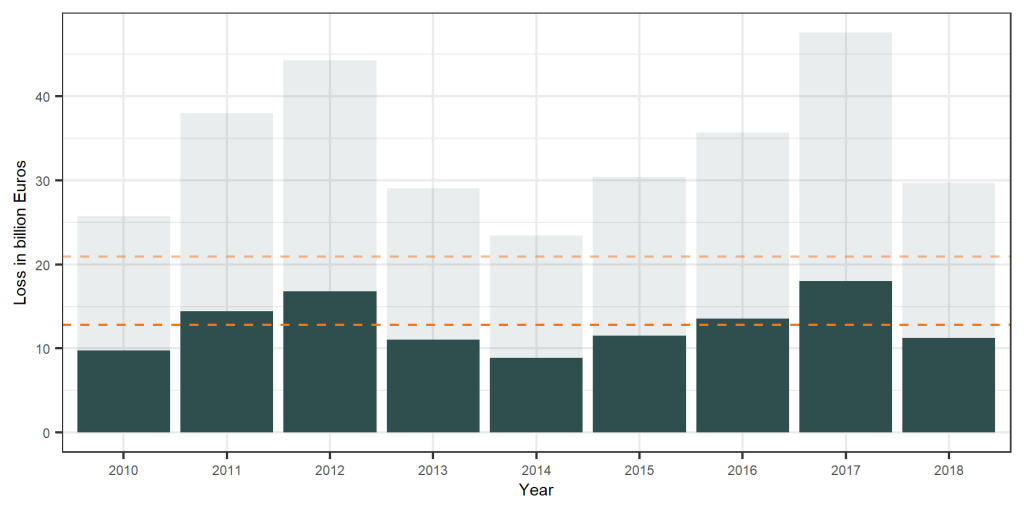
Figure 3: Annual loss estimates based on a decrease in the regional GDP growth rate for Southern Europe in billion euros (2010-2018). The solid bars indicate the lower bound and the transparent bars the upper bound of the estimate. The orange lines indicate the annual average losses (lower and upper bound) for the entire period with an average of 102 wildfire affected regions per fire season.
Note that these results are average effects and masks significant variation between regions. For the most severe wildfire years and most heavily affected regions, the annual GDP growth rate can decrease by as much as 3.3-4.8% using fire numbers and burned area, respectively.
We find no effect of wildfires on aggregate employment growth. Our results suggest that this is driven by the fact that certain employment activity sectors experience positive employment growth while others are negatively affected. The heterogeneous effects (point estimate and confidence intervals) of fire numbers on employment growth by the NACE economic activity sectors are shown in Figure 4. We find that category G-J that includes activities such as wholesale and retail trade, transport, accommodation, and food service activities experienced a negative employment effect of 0.09-0.15%, plausibly because of disruptions related to tourism. On average, 62,500 persons (29% of the working population) are employed in the retail and tourism sections G-J per region. Thus, using the average number of affected regions per year our estimates translate into approximately 5,700 to 9,500 jobs lost annually for Southern Europe in this employment category.
In contrast, our results show a positive effect of wildfires on regional employment growth of 0.13-0.22% in sectors including financial, insurance, and real estate activities, as well as short-term contracting activities. On average, 32,100 people (11% of the working population) work in sections K-N per region. This indicates an annual job creation of about 4,300 to 7,200 jobs related to financial, insurance, and real estate activities in Southern Europe.
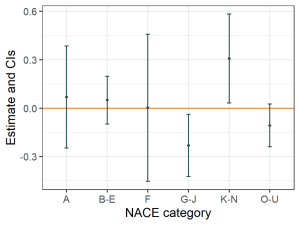
Figure 4: The effect of fire numbers on regional employment growth by economic activity category for 2010 to 2018 as shown with the regression coefficient and the corresponding confidence intervals. Category A includes agriculture, forestry, and fishing. Categories B-E capture industry except construction while category F denotes construction. Categories G-J include wholesale and retail, transport, and accommodation. Categories K-N contain financial, insurance, and real estate activities, and categories O-U includes public administration and defence.
Conclusion
In this research we link high resolution satellite data of aggregate wildfire burned areas with regional economic data for Southern Europe, enabling us to contribute to a deeper understanding of how these events impact local economic outcomes. Given that wildfire incidents are likely correlated with various unobservable factors, such as land management policies, wildfire prevention strategies, and land-use changes, and can be set intentionally, the events are treated as endogenous in our analysis. To overcome this concern, we use a measure of wildfire occurrence probability for predominantly forested areas based on relevant climatic features as an instrumental variable, while controlling for fire danger in non-forested area as well as for general climatic conditions that might directly affect regional economies. Importantly, the analysis indicates that not taking account of the endogeneity of wildfires is likely to lead to biased estimates on economic impacts. The proposed instrumental variable strategy might thus also prove to be a useful approach for other researchers interested in the economic implications of wildfires.
Our study provides novel evidence that wildfires lead to a significant decrease in the regional GDP growth rate for Southern Europe. Although wildfires have formed an integral part of the Mediterranean landscapes for centuries, the public institutional response could benefit from an extensive evaluation of mitigation and prevention mechanisms (e.g., mechanical clearing, prescribed burning, grazing, land management activities) to reduce the negative impacts on local economies. As illustrated in (Bayham et al., 2022), economic interdependencies and inefficiencies in fire-prone landscapes render wildfire management highly complex and large research gaps remain. European wide data collection efforts on these aspects at the regional level would allow researchers to further investigate the possible role of these interventionist factors. Such insights would importantly allow regional policy makers to explicitly evaluate strategies to strengthen the resilience of regional economies, particularly since the potential damage of wildfires is predicted to become more pronounced in the future (Dupuy et al., 2020).
References
Bayham, J., Yoder, J. K., Champ, P. A., & Calkin, D. E. (2022). The economics of wildfire in the United States. Annual Review of Resource Economics, 14.
Butry, D. T., Mercer, D. E., Prestemon, J. P., Pye, J. M., & Holmes, T. P. (2001). What Is the Price of Catastrophic Wildfire? Journal of Forestry, 99(11), 9–17.
Damania, R., Desbureaux, S., & Zaveri, E. (2020). Does rainfall matter for economic growth? Evidence from global sub-national data (1990–2014). Journal of Environmental Economics and Management, 102, 102335. https://doi.org/10.1016/j.jeem.2020.102335
Dupuy, J., Fargeon, H., Martin-stpaul, N., Pimont, F., & Ruffault, J. (2020). Climate change impact on future wildfire danger and activity in southern Europe: a review. Annals of Forest Science, 77(35).
Gellman, J., Walls, M., & Wibbenmeyer, M. (2022). Wildfire, smoke, and outdoor recreation in the western United States. Forest Policy and Economics, 134(October 2021), 102619. https://doi.org/10.1016/j.forpol.2021.102619
Horwich, G. (2000). Economic Lessons of the Kobe Earthquake. Economic Development and Cultural Change, 48(3), 521–542. https://doi.org/10.1086/452609
Iammarino, S., Rodriguez-Pose, A., & Storper, M. (2019). Regional inequality in Europe: evidence, theory and policy implications. Journal of Economic Geography, 19(2), 273–298. https://doi.org/10.1093/jeg/lby021
Kramer, H. A., Butsic, V., Mockrin, M. H., Ramirez-Reyes, C., Alexandre, P. M., & Radeloff, V. C. (2021). Post-wildfire rebuilding and new development in California indicates minimal adaptation to fire risk. Land Use Policy, 107, 105502. https://doi.org/10.1016/j.landusepol.2021.105502
Otrachshenko, V., & Nunes, L. C. (2022). Fire takes no vacation: impact of fires on tourism. Environment and Development Economics, 27(1), 86–101. https://doi.org/10.1017/S1355770X21000012
Rego, F., Louro, G., & Constantino, L. (2013). The impact of changing wildfire regimes on wood availability from Portuguese forests. Forest Policy and Economics, 29, 56–61. https://doi.org/10.1016/j.forpol.2012.11.010
San-Miguel-Ayanz, J., Durrant, T., Boca, R., Libertà, G., Branco, A., De Rigo, Ad., Ferrari, D., Maianti, P., Vivancos, T. A., Oom, D., Pfeiffer, H., & Grecchi, R. (2022). Forest fires in Europe, Middle East and North Africa 2021. https://doi.org/10.2760/34094
Sullivan, A., Baker, E., & Kurvits, T. (2022). Spreading like wildfire: The rising threat of extraordinary landscape fires. In A UNEP Rapid Response Assessment. https://doi.org/10.1038/news000413-8
Wang, D., Guan, D., Zhu, S., Kinnon, M. Mac, Geng, G., Zhang, Q., Zheng, H., Lei, T., Shao, S., Gong, P., & Davis, S. J. (2021). Economic footprint of California wildfires in 2018. Nature Sustainability, 4(3), 252–260. https://doi.org/10.1038/s41893-020-00646-7


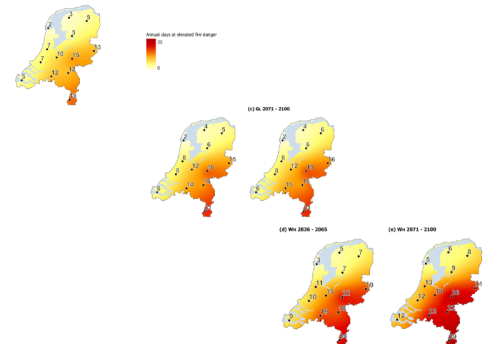
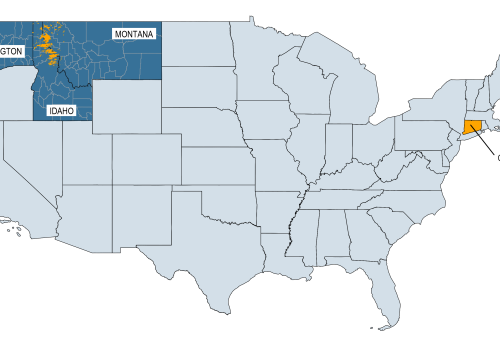

Leave a Reply